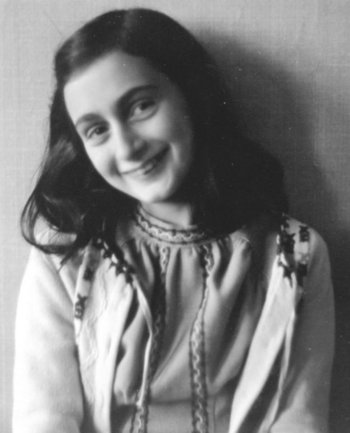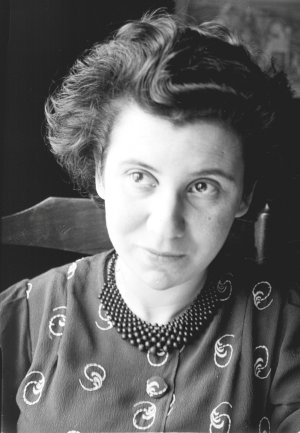| Â Â |
Winter 2015Â Â Â Â |
|
|     |  |     |      Browse our  |
 | Â
Â
Vapor Trails in Amsterdam, 1941-1943
By Elias Keller
Can you guess the Anne? From the same entry:
That's Anne Frank, age fifteen, from her very last diary entry before she and the other residents of the secret annex at Prinsengracht 263 in Amsterdam were betrayed, captured and deported to the Bergen-Belsen death camp. It wasn't until recently that I read Anne Frank's Diary of a Young Girl, although many middle-school students read it as part of their curriculum. But reading it at an older age (and unforced), I felt better equipped to appreciate why this remarkable document has garnered so much attention and praise. Those who read the Diary in school would do well to take a second look. To read Diary of a Young Girl is to be drawn into Anne Frank's inner world, to live in the secret annex with this contemplative girl, to be entertained by her witty prose about her crabbed housemates, to be heartened by her irrepressible positivity-until our acquaintance ends all too abruptly. The sparkling prose puts the reader so close to Anne Frank that her death is disturbing in surprisingly personal way. Reading her final words, and then the circumstances of her death, I grieved not for a "Holocaust victim," not for just one of six million: but for a girl, a person, a writer murdered not long after penning such timeless words:
While immersed in Anne Frank's Diary, a friend drew my attention to Etty (Esther) Hillesum, often tagged the "adult counterpart" to Anne Frank. Born fifteen years before the latter, Hillesum also lived in Amsterdam during the Holocaust, keeping a journal and writing letters that would be published posthumously in 1981 as An Interrupted Life & Letters from Westerbork. But beyond Holocaust scholars and some literary connoisseurs, few have read Hillesum's work or even know of her. Why is Etty Hillesum obscure while Anne Frank is a global icon? Hillesum's journals and letters are just as gorgeously composed and profound-perhaps more so in an absolute-value sense, because of her advanced age-but they are also a more challenging read, certainly not suitable for a middle-school curriculum. An industrious literary worker who translated Dostoyevsky's works from Russian, Hillesum's journals are relentlessly incisive and self-reflective, analyzing her motives and her practice of radical tolerance:
Hillesum uses her journal to discuss her daily life in Nazi-occupied Amsterdam, but also to explore religion and spirituality, ideal love versus sexual attraction, mental and physical illness, even existence itself: "The soul has a different age from that recorded in the register of births and deaths. At your birth, the soul already has an age that never changes," she wrote in 1942. Another reason for Etty Hillesum's obscurity is that she lived much of her life outside of the mainstream: she shunned traditional relationships, for example, and took at least two controversial lovers, including the charismatic chiromancer Julius Spier. She also isn't as photogenic as the (truly) adorable Anne Frank, and her name isn't quite as catchy. A deeper reason for her obscurity may be that Hillesum's exceptionally altruistic choices during the Holocaust are difficult to comprehend. Though she might have used her connections in the Jewish Council to successfully flee Nazism, she repeatedly refused to do so, believing that the more important work was to help others struggling to bear the horrors. Later, Hillesum tended to the ragged inmates of the dreadful Dutch transit camp of Westerbork for as long as she could-"There was a little old woman who had left her spectacles and her medicine bottle at home on the mantel: could she go and get them now, and where exactly was she, and where would she be going?"-and then boarded a train to Auschwitz in September 1943. Her final missive, a postcard thrown from that train, tells that she left Westerbork singing. But mostly, perhaps, Etty Hillesum remains largely uncelebrated because her journal is a weighty, serious work, with deep philosophical and psychological penetration on every page. Not since reading the journals of May Sarton, especially her Journal of a Solitude, have I been so enchanted and affected by such writings.-Yet praising Hillesum's writings so highly is not to depreciate Anne Frank's. The best thing about my introduction to Etty Hillesum was the opportunity to juxtapose her with Anne Frank. The journal and the diary may be separate works by separate individuals at different stages of corporeal life-but the ink that flows through them is the same. If their external lives were different, their inner lives, especially how they perceived their own acutely sensitive personalities (and their flippant decoys), bear remarkable resemblance. Look back to the top and reread the passage by Anne Frank, then read below from Etty Hillesum in 1942. She was twenty-eight and had nineteen more months to live, mostly in Westerbork, before being deported to Auschwitz.
And once more Anne Frank, the final words (a bit abbreviated) of her diary:
Encountering such similarities between the two consciousnesses, I began to see Anne Frank and Etty Hillesum as two incarnations of a single force, two sublimations of something almost invisible. A vapor trail, perhaps, of rare compassion and, rarer still during those desolate years, an unassailable belief in the underlying goodness of people. What else, during those years, was left to nourish the famished spirit of the Jewish people, indeed all starving spirits oppressed by Nazism's brute force?-except that vapor trail, which might have dissipated without a trace if not for uncommonly sensitive minds and pens. Thankfully, in the writings of Anne Frank and Etty Hillesum, two sublime voices in perfect harmony, we find an enduring artifact of that vapor. It's worthwhile to describe Etty Hillesum as the "adult counterpart" of Anne Frank if it leads more readers to the treasure chest of An Interrupted Life & Letters from Westerbork. I have yet to hear, though, anyone call Anne Frank the "child counterpart" of Etty Hillesum. But she is indeed, and what a sensation to read both girl and woman, to feel that soulful vapor in different words on different pages, but none lesser, or greater, than any other. http://en.wikipedia.org/wiki/Etty_Hillesum http://en.wikipedia.org/wiki/Anne_Frank http://en.wikipedia.org/wiki/May_Sarton from the Winter 2015 Edition of the Jewish Magazine Material and Opinions in all Jewish Magazine articles are the sole responsibility of the author; the Jewish Magazine accepts no liability for material used. |
 |  
|
 |  |  |
| All opinions expressed in all Jewish Magazine articles are those of the authors. The author accepts responsible for all copyright infrigments. |





